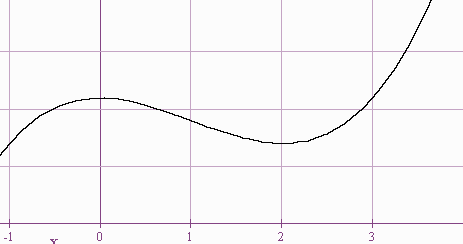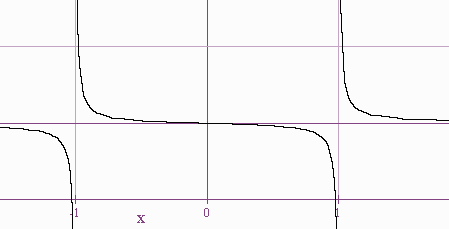Graphing Rational Functions
I. Quiz
II. Homework
III. Curve Sketching
List of interesting parts of a graph
A) x-intercepts
B) y-intercepts
C) Domain and Range
D) Continuity
E) Vertical Asymptotes
F) Differentiability
G) Intervals of Increase and Decrease
H) Relative Extrema
I) Concavity
J) Inflection Points
K) Horizontal Asymptotes
Example:
Graph x3 - 3x2 -9x
1. We find the x intercepts by factoring out the x and putting into the quadratic formula.
(-1.8,0), (0,0), (4.9,0).
2. Note that the y intercept is also (0,0).
3. The domain is R since this is a polynomial.
4. The function is continuous since it is a polynomial.
5. There are no vertical asymptotes since we have a polynomial.
6. The function is differentiable everywhere.
7. We find f'(x) = 3x2 - 6x - 9 = 3(x - 3)(x + 1).
We see that f is increasing on (-infinity,-1) and on (3,infinity). f is decreasing on (-1,3)
8. By the first derivative test, f has a relative maximum at (-1,5) and a relative minimum at (3,-27)
9. f''(x) = 6x - 6, so that f is concave down on (-infinity,1) and concave up on (1,infinity)
10. f(x) has an inflection point at (1,-11)
11. f has no horizontal asymptotes.
The graph of f is shown below:

Example
Graph x /(x2 - 1)
x-int at (0,0)
Same for y-int
f'(x) = ((x2 - 1)(1) - x(2x))/(x2 - 1)2 = (-x2 - 1)/(x2 - 1)2
f'(x) = 0 never, so there are no local extrema
and f(x) is increasing when x > 1 or x < -1

is 0 when x = 0 is positive when x is between - 1 and 0 or x is greater than 1. This is where f(x) is concave up. It is concave down elsewhere except at 0 and +-1.
F(x) has a vertical asymptote at x = 1 and -1.
The horizontal asymptote is y = 0.
